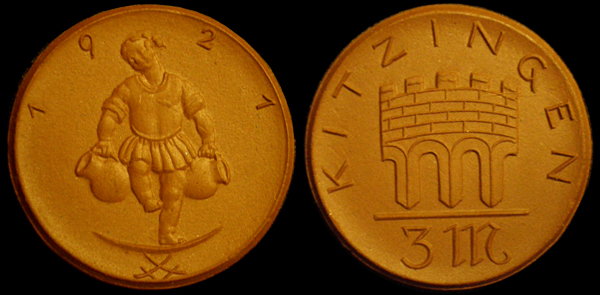
KITZINGEN 3 MARK 1921
Town of Kitzingen 3 Mark Porcelain Coin Depicting Little Girl Walking with Jugs and Turret From Town Crest Minted by Meissen Porcelain Works.
Kitzingen is a town in the German state of Bavaria and is part of the Franconia geographical region with around 21,000 inhabitants. Kitzingen County is the largest wine producer in Bavaria. Until recently it was the home of two US military bases.
This is a reddish brown stoneware coin minted by the famous porcelain works at Meissen in Germany. This coin displays the crossed swords found on every product of the Meissen porcelain works since 1722 including the white and brown porcelain coins and medal minted during this time. Although both white and brown porcelain coins and medal were produced, brown porcelain was often preferred over white for circulation due to the fact that it was less effected by dirt, breakage and wear.
Although the use of porcelain for coins and medals was not a new concept as Meissen had produced its first porcelain medallion as far back as 1710, regular production of German porcelain coins as currency for a variety of towns, cities, and regains (emergency money and donation coins) began at the end of 1920 and in the first months of 1921. A limited numbers of these coins were produced from plaster casts for Germany and for the State of Saxony. These earlier limited issue coins are remarkable for having finer, less sharp lines, rougher surfaces and are thinner than the ones later minted from steel moulds. Later issues such as the one pictured above were produced in large numbers from steel casts and are characterized by thicker flans and sharper detail.
Porcelain coins with face values from 10 pfennigs to 20 marks were issued in a variety of types and numbers for many German cities and regions at the beginning of the 1920s. Although these coins were reportedly very popular do to their attractive, interesting and varied designs, they were impractical as coinage do to the fact that they broke rather easily and did not hold up the rigors of circulation for long. They ultimately failed as currency thus circulation of these coins was very limited though commemorative and special issue porcelain coins and medals continued to be produced.
